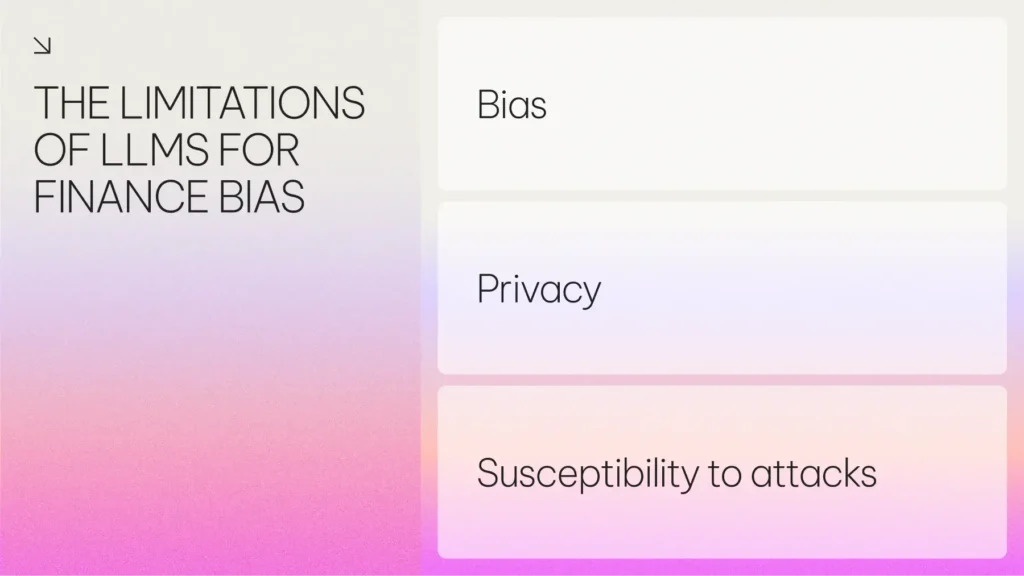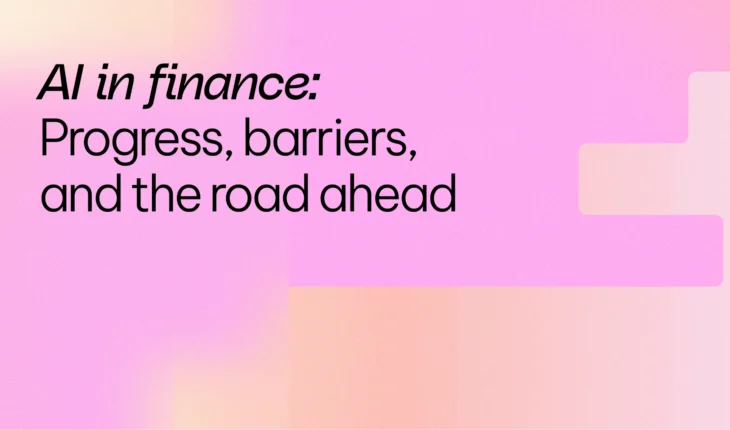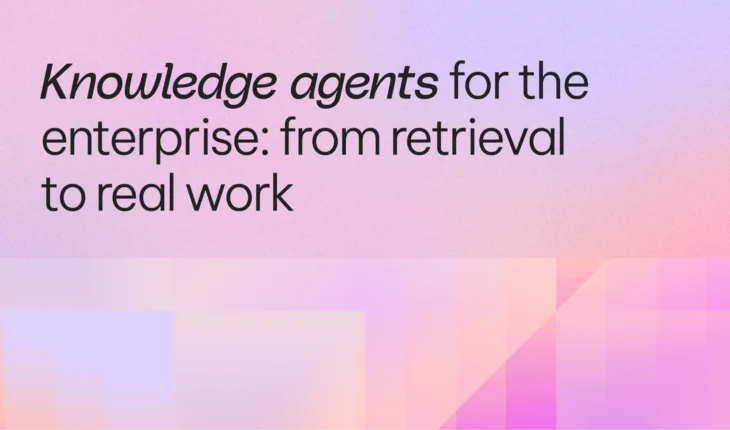
LLMs in Finance: Applications, Examples, & Benefits
The finance industry is one of complexity, with millions of data points, high-stakes decisions, and markets that can shift in seconds. Under pressure to move faster and make more informed decisions, financial professionals are turning to large language models (LLMs) for a competitive edge.
The latest generative AI tools can interpret regulatory filings, summarize earnings reports, forecast market trends, and even power client-facing chatbots, and as such, LLMs are already reshaping financial operations.
Across the global banking sector, generative AI is expected to add between $200 billion and $340 billion in annual value. However, there’s a catch: LLMs only drive results when deployed with the right tools, data, and oversight.
The latest move is towards using LLMs that can handle long-context processing, which enables deeper document understanding and broader contextual recall. Interested in a more effective LLM for finance? This article explains all you need to know.
What are LLMs in finance?
Large language models (LLMs) are a type of artificial intelligence designed to understand, generate, and analyze human language. They use natural language processing (NLP) to perform tasks such as summarization, classification, and question answering.
These models are trained on massive volumes of text and are built to process language in a way that mimics human understanding.
LLMs are highly effective for tasks such as:
- Content creation (e.g., writing articles, summarizing reports).
- Sentiment analysis (e.g., analyzing customer feedback).
- Conversational AI (e.g., chatbots, virtual assistants)
In finance, LLMs have many uses. They can interpret complex financial documents, extract insights from earnings calls, analyze market sentiment, and provide concise summaries of regulatory filings and research reports.
Fine-tuned private deployments in financial services are now standard for extracting real-time insights or other tools, all utilizing training across financial documents, industry-specific content such as SEC filings, news headlines, and company reports.
As a result, they are better equipped to understand financial terminology and context, which enables them to outperform general-purpose models on tasks such as sentiment analysis and headline classification.
The ongoing impact of LLMs on Finance
Large language models have gained momentum in financial services thanks to the growing accessibility of retrieval-augmented generation (RAG).
RAG is a technique that enhances generative AI models by connecting them to trusted external or internal data, and enhances an LLM’s capabilities, and is explicitly designed to work with long-form documents, like financial records.
By grounding responses in internal, proprietary data through an RAG engine, it’s possible to mitigate hallucinations and ensure verifiable outputs, particularly valuable in finance, where accuracy and traceability are critical.
As such, LLMs are making a measurable impact across key functions:
- Data analysis: LLMs trained on financial data can identify patterns in unstructured sources, such as earnings reports or market movement data, to guide investment decisions.
- Portfolio management: These models can analyze macroeconomic trends and assist with portfolio allocations, supporting risk mitigation and smarter investment strategies.
- Compliance: LLMs can monitor transactions in real-time for potential violations, helping to reduce regulatory risk and ease the compliance burden.
- Customer engagement: AI-powered chatbots offer 24/7 support, answer client questions, and clearly explain financial concepts, thereby enhancing financial literacy and customer satisfaction.
LLM applications for finance
Because these models are trained on vast financial datasets, they can process complex information at speed and generate insights in plain language, freeing up analysts and executives to focus on decision-making, not data crunching.
Financial text summarization
LLMs can distill dense content, such as earnings reports, investor presentations, and market commentary, into clear summaries. This helps stakeholders quickly grasp key insights without having to read lengthy documents.
Unlike traditional systems, LLMs can handle unstructured data from sources such as news, social media, and analyst calls. This enables more accurate, consistent reporting. They also highlight critical points, allowing the professionals to identify trends and monitor shifts in sentiment.
Performing accurate data analysis
LLMs analyze reports, transcripts, and economic data in real time. They can produce research summaries that would take human analysts hours to compile.
By detecting patterns in historical data, LLMs support stock forecasting and trend detection. In portfolio management, they facilitate scenario modeling and risk evaluation by processing large volumes of variables efficiently and recommending data-driven strategies.
Fraud detection and prevention
LLMs can identify irregularities in transactions and communications by understanding context, not just patterns. This makes them more effective than rule-based systems for detecting suspicious behavior.
In compliance, LLMs scan communications and documents to verify regulatory alignment, thereby reducing manual workload and minimizing risks.
Personalized customer service
LLMs enhance service by understanding customer intent, tone, and goals. Fine-tuned models can recommend tailored financial products and investment plans based on an individual’s income, expenses, and risk tolerance.
They also improve onboarding. LLMs guide new users through account setup, explain services in plain language, and suggest features based on preferences, creating a smoother, more relevant experience. For example, Jamba enhanced a chatbot’s grounded Q&A precision by a huge 21%.
Processing Financial Data
LLMs extract, organize, and analyze unstructured data, including call transcripts and legal documents. Named entity recognition helps identify and categorize elements like company names, values, and timestamps, enabling automatic classification of complex data.
FinLLMs (finance-specific models) can summarize documents and assess sentiment in headlines or reports, with benchmark data showing tools like Jamba 1.6’s long-context summarization and sentiment classification can outperform open models.
These specific models are ideal for trading strategies and risk analysis.
LLMs also help forecast market trends by analyzing historical and real-time data to identify signals of price movement or economic shifts. While human oversight remains essential, these models improve the depth and speed of forecasting.
Real-world examples of LLMs in finance
Mastercard is deploying LLMs through its Decision Intelligence Pro tool, which uses a custom-built recurrent neural network trained on 125 billion annual transactions. The system tracks behavioral patterns and assesses risk in real time, with early results showing up to a 300% improvement in fraud detection.
J.P. Morgan leverages a proprietary AI model for document understanding across forms, invoices, and reports. Rather than relying on image encoders, its LLM processes bounding box data from optical character recognition (OCR). This means instead of just looking at document images, their AI reads the data about where text appears on the page, knowing what a heading is, what a table is, and what goes together much more accurately.
Bank of America’s virtual assistant, Erica, uses a proprietary LLM to power over two million daily client interactions. Designed to understand natural language and intent, Erica helps users manage subscriptions, track spending, and complete transactions. Since launch, it has supported more than 42 million clients, resolving 98% of queries in under 44 seconds across more than two billion interactions.
The benefits of LLMs for finance
Large language models (LLMs) are transforming the financial sector by processing complex data and generating insights using natural language. Their ability to scale across language- and data-driven tasks positions them as essential tools for modern financial institutions.
Operational enhancements
LLMs automate time-consuming tasks such as summarizing earnings reports, generating investment updates, and analyzing stock performance. They reduce manual effort in financial reporting and document processing, improving accuracy and streamlining workflows.
LLMs streamline data extraction, improve consistency, and lower the risk of human error.
Enhanced decision making
LLMs enhance strategic planning by analyzing market sentiment, identifying anomalies in transactional data, and enabling predictive analytics. These capabilities support better risk management, fraud prevention, and data-driven investment decisions. Financial institutions can use LLMs to monitor investor confidence and forecast macroeconomic shifts in real time.
Natural language interfaces
In customer-facing roles, LLMs power intelligent chatbots and virtual assistants that deliver instant, personalized support. These tools answer questions, provide financial advice, and streamline interactions, enhancing customer satisfaction and improving service efficiency.
By understanding and generating financial language, LLMs also facilitate easier interpretation of complex financial information for customers. Additionally, they support financial literacy by translating jargon into accessible explanations, helping users make more informed decisions.
What are the limitations of LLMs for finance?
While large language models (LLMs) present significant opportunities for financial institutions, they also introduce new challenges. Enterprise adoption of LLMs must be accompanied by a clear understanding of the risks, particularly in the areas of bias, privacy, and security.

Bias
LLMs are only as accurate as the data they are trained on. If models are built on biased or unbalanced datasets, their outputs may reflect and reinforce those biases. In finance, this can lead to skewed predictions or discriminatory recommendations, posing reputational, legal, and ethical risks. To mitigate this, financial firms must implement rigorous bias testing, continuous monitoring, and aim for transparent model governance with any LLM system.
Privacy
Financial data is highly sensitive, and LLMs trained on mixed datasets may inadvertently retain or reveal proprietary or regulated information. For example, without proper safeguards, there is a risk of unintentionally exposing confidential data during model interactions.
There are solutions, such as applying strict data vetting, implementing anonymization protocols, and ensuring compliance with privacy regulations and financial sector-specific standards, which are far easier to apply with a private AI deployment.
Susceptibility to attacks
LLMs are vulnerable to adversarial techniques, including prompt injection, model manipulation, and data poisoning. These threats can distort outputs, bypass safety measures, or leak sensitive information. In high-stakes financial environments, these risks are amplified.
Enterprises must embed security into the model development lifecycle, conducting regular audits, applying adversarial testing, and implementing robust safeguards to defend against emerging threats.
Open-Source vs. Closed-Source Models for Financial LLMs
Financial institutions adopting large language models (LLMs) must choose between open-source and closed-source solutions, each presenting trade-offs across cost, control, customization, and data governance.
Open-source LLMS for finance
Open-source LLMs are more commonly designed for private deployment in regulated sectors, enabling full compliance and control over data pipelines within enterprise infrastructure.
They offer full access to the model’s architecture and parameters. This transparency enables institutions to tailor models extensively for specific financial applications.
Open-source models are often more cost-effective to fine-tune than commercially licensed alternatives and can be tailored to fraud detection, credit scoring, or investment analysis. Their interpretability supports model auditability, and because they can run on-premises, open-source LLMs provide enhanced data privacy by keeping sensitive financial information within the organization’s infrastructure.
However, open-source models also present challenges. Their success depends heavily on access to high-quality, domain-specific datasets, which must be curated internally. The complexity of financial language increases the risk of hallucinations, plausible but inaccurate outputs, making it necessary to apply advanced refinement techniques such as reinforcement learning from human feedback.
Additionally, open-source deployment requires skilled machine learning teams to manage ongoing fine-tuning and performance maintenance, which may be a barrier for smaller organizations.
Closed-source LLMs for finance
Closed-source LLM models like ChatGPT, Claude, and BloombergGPT are commercially licensed and maintained by third-party providers. These models are trained on vast datasets and often perform well out of the box, offering immediate functionality for various general financial tasks. They also demand less technical expertise, making them suitable for teams with limited AI experience or constrained technical resources.
Their APIs typically restrict access to the model’s internal workings, which can limit customization and flexibility.
Ultimately, the decision between open-source and closed-source LLMs depends on an institution’s in-house capabilities, data sensitivity, and the need for customization. Each approach offers value; what matters is aligning the choice with operational needs and long-term strategy.
The future of Financial LLMs
While today’s most well-known large language models (LLMs) excel at general tasks such as question answering and code generation, financial institutions require models with in-depth domain expertise to unlock genuine operational value.
The future will see an increasing demand for domain-specific LLMs that are tailored to comprehend intricate financial terminology, structured data, and industry-specific regulations.
As laws and compliance changes, there may be even greater need for great control over data governance and security, whilst also offering greater flexibility and compliance in AI deployments.
FAQs
-
In finance, LLM stands for Large Language Model. These are advanced AI models trained on massive datasets to understand and generate human-like text. Using natural language processing (NLP), large language models (LLMs) can interpret financial documents, analyze market sentiment, and track trends in real-time. The term “LLM” distinguishes these models from earlier, smaller-scale predecessors, emphasizing their scale and capabilities.
-
The most effective LLMs for finance are domain-specific models that have been fine-tuned on financial datasets. These models are better equipped to handle nuanced language, industry terminology, and structured data. Financial institutions that embrace domain-specific LLMs today will be best positioned to lead tomorrow’s AI-driven economy.


